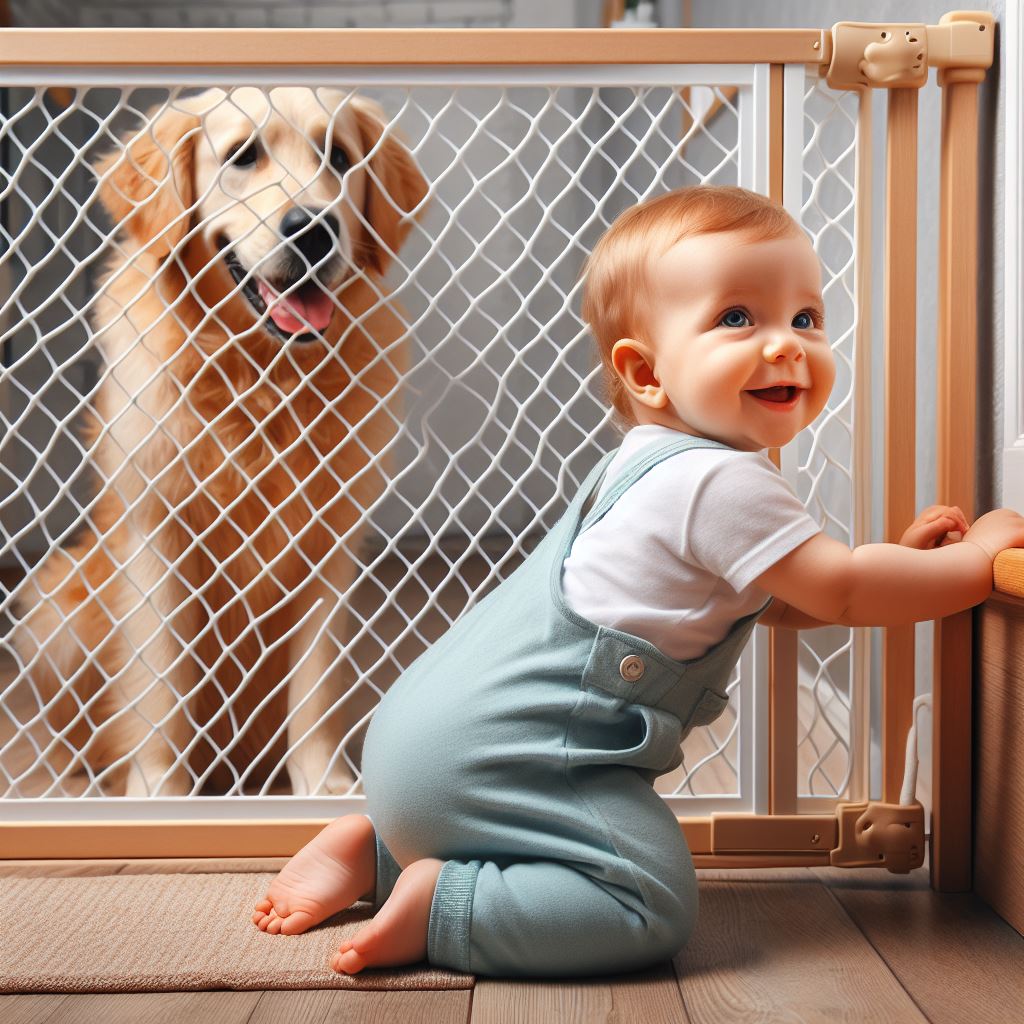Importance of Baby Safety Gates
When it comes to safeguarding your home and ensuring the well-being of your little ones, baby safety gates play an indispensable role. These essential barriers serve as guardians, preventing access to potentially hazardous areas while granting freedom within secure spaces.
Ensuring Child Safety
The paramount importance of baby safety gates lies in their ability to protect curious explorers from accessing areas that could pose risks. By strategically installing these gates, parents and caregivers create safe zones, limiting access to stairs, kitchens, or rooms with potential dangers.
Promoting Independence and Security
Interestingly, while baby safety gates are designed to restrict access to certain areas, they also facilitate a sense of security and independence for children. By delineating safe spaces, these gates allow kids to roam and explore freely, ensuring their safety within designated zones.
Aiding in Childproofing Homes
A crucial facet of installing baby safety gates involves the broader concept of childproofing. It’s not merely about keeping children away from hazards but creating an environment that’s safe for them to thrive in. Safety gates serve as pivotal tools in this comprehensive approach.
Enhancing Peace of Mind
For parents and caregivers, the installation of safety gates is more than a physical barrier; it’s peace of mind. Knowing that certain areas are off-limits and secure provides a sense of assurance, especially during busy moments or when multitasking.
In this guide, we’ll delve deeper into the significance of baby safety gates and their pivotal role in safeguarding your home and, more importantly, your precious little ones. Understanding their importance sets the stage for a comprehensive installation guide that empowers you to create a haven within your home.
Types of Baby Safety Gates
Baby safety gates come in various types, each designed to cater to specific needs and environments within your home. Understanding the distinctions between these gate types is crucial to selecting the most appropriate one for your space.
Pressure-Mounted Gates
- Characteristics: These gates use pressure to stay in place, without requiring drilling or permanent installation.
- Flexibility: Ideal for areas without permanent fixtures or when temporary barriers are needed.
- Considerations: Not recommended for use at the top of stairs due to stability concerns.
Munchkin Lindam Stair Gate
| Manufacturer | Munchkin |
| Model | Pressure Fit Safety Gate |
| Material | Alloy Steel |
| Product dimensions | 110W x 73H centimetres |
| Item weight | 7.06 Ounces |
Hardware-Mounted Gates
- Structural Support: These gates are attached by hardware, offering a more permanent and secure fixture.
- Stability: Suitable for both doorways and staircases, providing sturdy barriers.
- Installation: Requires drilling into walls or door frames for optimal security.
Choosing the Right Gate Type
- Space Analysis: Assess the areas where gates are needed to determine the suitable type.
- Consider Safety: Evaluate whether the gate will be installed at the top or bottom of stairs and the necessity for a more secure fixture.
- Long-Term Use: Determine if the gate will be used temporarily or for an extended period, influencing the choice between pressure-mounted or hardware-mounted gates.
Complementing Home Safety Measures
Selecting the right type of baby safety gate is not just about functionality but also about enhancing the overall safety measures in your home. By understanding the distinct features and limitations of pressure-mounted and hardware-mounted gates, you can effectively implement these barriers to create secure spaces for your child to explore safely.
Essential Tools Needed
For a successful installation of baby safety gates, having the right tools at your disposal is fundamental. Each gate type and its unique mounting requirements may call for specific instruments and accessories to ensure a secure and accurate installation process.
Tools for Pressure-Mounted Gates
- Measuring Tape: Essential for determining the gate’s width and the space available for installation.
- Pressure Gate Kit: Some gates come with specialized kits for pressure mounting; these kits often include screws or clamps.
Tools for Hardware-Mounted Gates
- Power Drill: Necessary for creating holes for screws or bolts during installation.
- Screwdriver Set: To securely fasten the hardware and brackets.
- Stud Finder: Helps locate sturdy areas in the wall for mounting brackets, ensuring a strong fixture.
Common Tools for Both Gate Types
- Level: To ensure the gate is installed horizontally and maintains its stability.
- Pencil or Marker: Used for marking points where holes need to be drilled or where pressure clamps will be placed.
- Hardware (Screws, Bolts, Clamps): Depending on the gate type, have the necessary hardware readily available.
Safety Precautions
Before commencing the installation process, ensure that you’re equipped with appropriate safety gear. While installing pressure-mounted gates might not involve power tools, hardware-mounted gates might require drilling and handling heavy equipment. Protective eyewear, gloves, and ensuring a stable work area can prevent accidents during the installation.
Consider the Gate Model
Always refer to the manufacturer’s guidelines and recommendations regarding the necessary tools. Different gate models might have specific requirements or additional tools suggested for an optimal installation process.
Gathering the Tools
Before starting the installation, assemble all the required tools and have them within reach. This ensures a smooth installation process without interruptions to search for missing tools, making the entire process more efficient and less time-consuming.
Preparing the Installation Area: Measurement and Marking
Before initiating the installation process for your baby safety gate, it’s pivotal to prepare the installation area meticulously. One of the primary aspects of this preparation involves accurate measurement and marking of the gate placement area. This stage significantly contributes to the gate’s stability and effectiveness in creating a secure barrier for your child.
Measurement for Gate Width and Height
- Width Measurement: Begin by measuring the width of the space where you intend to install the gate. Ensure to take multiple measurements at various heights to account for any variations in the opening width.
- Height Measurement: Equally crucial is determining the gate’s height to guarantee it adequately spans the opening, preventing any climbing accidents.
Marking the Installation Area
- Horizontal Alignment: Use a level to ensure the gate aligns horizontally. Mark the points where the gate will be installed, paying close attention to maintaining a straight line to prevent any inclinations.
- Vertical Alignment: For hardware-mounted gates, marking the spots where you’ll need to drill is crucial. Use a pencil or marker to indicate the precise points.
Considerations for Banisters and Stairs
- Bannister Evaluation: If installing the gate on a bannister, assess the bannister’s structure and composition. Ensure it’s sturdy enough to support the gate’s mounting.
- Stair Surface: On staircases, ensure the surface where the gate will be installed is even and doesn’t interfere with the gate’s mechanism. Also, assess the landing area to confirm there’s enough space for the gate to swing open if necessary.
Guidelines for Safe Marking
- Temporary Marking: Use removable markers or tapes for initial markings, allowing you to make adjustments as needed without damaging surfaces.
- Double-Check Measurements: Before proceeding to the installation phase, double-check all measurements and markings to ensure accuracy.
Taking Note of Manufacturer Guidelines
Always refer to the gate’s installation manual or manufacturer’s guidelines. These may offer specific instructions regarding measurements, placement, and marking, ensuring an optimized installation process.
Conclusion
Accurate measurement and marking of the installation area pave the way for a seamless installation process, contributing significantly to the gate’s stability and functionality. Taking the time to measure accurately and mark the areas precisely will result in a safe and secure installation that effectively safeguards your child’s environment.
Securing Pressure-Mounted Gates
When it comes to securing pressure-mounted baby safety gates, ensuring a firm and stable installation is crucial for optimal functionality and safety. Unlike hardware-mounted gates that rely on screws for stability, pressure-mounted gates use tension to stay in place. Here, we delve into the steps required for a secure installation of these types of gates.
Locate Suitable Positions
- Identify Pressure Points: Pressure-mounted gates work by pressing against opposing walls or surfaces. Determine the most suitable areas where the gate can be securely held in place without causing damage.
- Consider Wall Material: Ensure the walls where you intend to position the gate can sustain the pressure. Avoid using these gates on weak surfaces that may give way under pressure.
Installing the Gate
- Adjust Tension Mechanism: Most pressure-mounted gates come with adjustable tension screws or mechanisms. Follow the manufacturer’s instructions to adjust the tension to an appropriate level. Over-tightening can damage walls, while insufficient tension may result in an unstable gate.
- Positioning: Place the gate in the designated area, ensuring it’s level and adequately aligned. Apply gentle pressure to both sides to engage the tension mechanism, securing it in place.
Testing for Stability
- Firmness Check: After installation, conduct a thorough check to ensure the gate is firmly secured. Gently push and pull the gate to confirm it doesn’t move or dislodge easily.
- Regular Inspection: Periodically check the gate’s stability. The tension might need readjustment over time due to changes in the wall or gate structure.
Precautions and Considerations
- Avoid Overextension: Some pressure-mounted gates may not be suitable for wider openings. Be cautious not to overextend these gates beyond their recommended width, as it might compromise stability.
- Childproof Latches: Double-check that the gate’s latching mechanism is childproof and can’t be easily opened by curious little hands.
Conclusion
Correctly securing pressure-mounted baby gates involves meticulous positioning, tension adjustment, and regular inspections. Following these steps diligently not only ensures a safe environment for your child but also maximizes the gate’s efficiency in preventing access to potentially hazardous areas.
Installing Hardware-Mounted Gates: A Detailed Guide
When installing hardware-mounted baby safety gates, precision and attention to detail are critical for a secure and reliable installation. These gates are fastened using screws and brackets, offering robust stability and durability. Let’s delve into the meticulous steps required for a successful installation.
Assessing Placement
- Identify Gate Placement: Determine the areas where the gate will be installed. Hardware-mounted gates are ideal for areas where a more permanent fixture is needed, such as the top or bottom of staircases.
- Consider Structure: Check the structure and material of the walls or surfaces where the gate will be installed. Ensure they can support the mounting hardware without compromising integrity.
Preparing for Installation
- Gather Necessary Tools: Collect the required tools, which typically include a power drill, screws, brackets, and a measuring tape. Follow the manufacturer’s recommendations for specific tools needed for the gate.
- Mark Mounting Points: Use a pencil to mark the spots where screws and brackets will be placed. Measurements should be precise to ensure the gate fits securely.
Gate Assembly and Attachment
- Assemble Gate Components: Follow the provided instructions to assemble the gate components accurately. Double-check that all parts are correctly aligned before proceeding.
- Mounting the Gate: Use the marked points as a guide to affix the brackets securely to the wall or door frame. Ensure the gate is level and aligned with the marked spots before drilling or screwing in place.
Testing and Safety Measures
- Gate Functionality Test: After installation, perform functionality tests by opening and closing the gate several times. Ensure it operates smoothly without sticking or dislodging.
- Child Safety Considerations: Verify that the gate’s locking mechanism works effectively and can’t be easily accessed or opened by children.
Maintenance and Care
- Regular Inspections: Periodically inspect the gate’s condition to detect any loose screws or signs of wear. Tighten any loose parts to maintain stability.
- Cleaning and Care: Follow the manufacturer’s guidelines for cleaning and maintenance. Keep the gate clean and free from debris that may affect its functionality.
Conclusion
The installation of hardware-mounted baby safety gates involves meticulous preparation, precise measurement, and secure attachment. By following these detailed steps, you ensure a robust and secure barrier that provides a safe environment for your child while maintaining the integrity of your home’s structure.
Safety Tips for Effective Usage
Ensuring the proper and safe use of baby safety gates is as crucial as their correct installation. Here are essential safety tips to optimize the functionality and reliability of these gates:
Regular Inspection
- Check Mechanisms: Periodically inspect the gate’s locking mechanisms to ensure they are functioning correctly. Test the gate by opening and closing it to verify smooth operation.
- Tighten Loose Parts: Routinely check for loose screws or fittings. Tighten any loose parts promptly to maintain stability.
Gate Placement
- Proper Installation Height: Install the gate at the appropriate height recommended by the manufacturer. Follow guidelines to ensure it effectively prevents your child from accessing restricted areas.
- Avoid Using Broken Gates: Do not use gates with broken or damaged parts. Replace or repair these gates immediately to maintain safety.
Usage Guidelines
- Educate Others: Ensure everyone in the household, including caregivers and family members, understands how to operate the gate correctly.
- Avoid Clutter Around Gates: Keep the gate area free from clutter or objects that might obstruct its function.
Child Supervision
- Monitor Children: Regularly supervise your child near safety gates, especially if they are very young or have just started walking.
- Educate About Safety: Teach older children about the gate’s purpose and instruct them not to climb or play on it.
Gate Maintenance
- Clean Regularly: Clean the gate regularly to remove dirt or debris that might affect its functioning.
- Follow Manufacturer’s Recommendations: Adhere to the manufacturer’s maintenance instructions for the specific type of gate you’ve installed.
Conclusion
By following these safety tips, you can ensure that the installed safety gates not only serve their purpose but also provide a secure environment for your child. Regular maintenance and proper usage play pivotal roles in sustaining the efficacy of these safety measures within your home.
Optimizing Gate Durability
Maintaining the durability of baby safety gates is paramount to ensure long-term effectiveness in childproofing your home. Implementing strategies to optimize the gate’s durability involves several key considerations:
Material Inspection
- Material Quality: Assess the material quality of the gate components. Ensure they meet safety standards and are durable enough to withstand regular use.
- Corrosion Resistance: Check for any signs of corrosion, especially in metal components, which might compromise the gate’s structural integrity.
Regular Maintenance
- Cleaning Routine: Establish a cleaning routine for the gate. Wipe down surfaces regularly to remove dust, debris, or any substances that could deteriorate the gate’s material over time.
- Lubrication of Moving Parts: Apply appropriate lubricants to hinges and moving parts to prevent rusting and ensure smooth operation.
Weather Considerations
- Outdoor Gates: If using gates outdoors, choose materials that withstand weather elements. Regularly inspect outdoor gates for wear and tear caused by exposure to sunlight, rain, or snow.
- Seasonal Inspections: Perform seasonal checks to address any damage caused by extreme temperatures or weather conditions.
Weight and Load Capacity
- Weight Limits: Adhere to weight limits specified by the manufacturer. Overloading the gate can lead to structural damage or failure.
- Child Impact Tests: Consider gates tested for impact resistance to ensure they can withstand accidental pushes or collisions from children without breaking.
Proactive Repairs
- Timely Repairs: Address any damages promptly. Fix or replace worn-out parts to prevent further deterioration or potential hazards.
- Expert Consultation: Seek advice from professionals if you notice significant damages beyond routine maintenance.
Conclusion
By adopting these measures, you can significantly enhance the longevity and effectiveness of baby safety gates within your home. Regular inspections, maintenance, and proactive repairs play pivotal roles in ensuring these safety features remain robust and reliable for your child’s protection.




